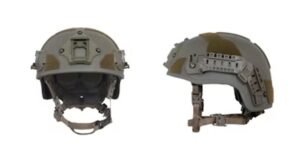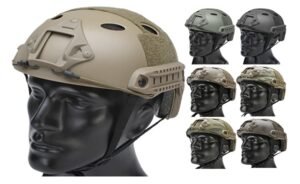Ballistic helmets are a crucial component of protective gear for military and law enforcement personnel involved in tactical missions. Choosing the right ballistic helmet ensures protection against various ballistic threats while providing comfort and a secure fit.
This article will explore key factors to consider when selecting the best ballistic helmet for your tactical needs. We will begin by assessing your operational requirements, followed by an overview of helmet materials and their ballistic ratings. Next, we’ll discuss the importance of helmet fit, comfort, and adjustability. Finally, we’ll review considerations related to helmet design and accessories.
Identifying Your Tactical Requirements
When choosing a ballistic helmet, it is essential to first assess the specific threats and protection levels needed for your operations. Additionally, the type of missions and roles you’ll be performing must be carefully considered. Compatibility with communication devices and other accessories should also be evaluated to ensure seamless integration during tactical operations.
Assessing Threat Levels and Ballistic Protection
Given the variety of potential threats, selecting a ballistic helmet that offers the appropriate level of protection is crucial. Ballistic helmets are typically categorized based on the type of threats they are designed to withstand. They are usually classified into two primary categories: helmets designed for handgun protection and those designed for high-powered rifle protection.
Helmets designed for handgun protection are usually rated on a scale from I to III, with III providing the highest level of protection. Helmets designed for high-powered rifles are rated from IIIa to IV, with IV offering the most protection. Some helmets also provide additional protection against fragmentation.
When selecting a ballistic helmet, it is important to evaluate the specific threats you may face and choose a helmet that provides the necessary protection. Additionally, ensure the helmet is properly fitted for comfort, especially for extended use. Don’t forget to check the expiration date of the helmet, as they lose their effectiveness over time and need to be replaced periodically.
Considering Mission Types and Roles
Different mission types and roles demand varying levels of ballistic protection. For example, a law enforcement officer conducting an arrest may need a lightweight helmet suitable for close-quarters engagements, whereas a soldier on the battlefield may require a heavier, more durable helmet.
The mission type and user role will influence the thickness, protection level, and additional features of the helmet. Lighter helmets are suitable for protection against lower-level threats, like shrapnel, but may not offer enough protection against more significant dangers such as rifle fire. Heavier helmets provide better protection but can be bulkier, potentially hindering mobility in certain missions or roles.
Carefully considering the mission and the role of the wearer is essential in selecting the right ballistic helmet.
Evaluating Compatibility with Communication Devices and Accessories
Before selecting a ballistic helmet, it is essential to evaluate its compatibility with communication devices and other accessories. While ballistic helmets are primarily designed for protection, they can also be outfitted with features such as radio communication systems and night vision goggles.
When making your selection, consider the following factors:
- Radio communication device compatibility: Different models of radio communication devices exist, and it is important to ensure that the helmet is compatible with the specific device you are using.
- Helmet size and shape: Helmets come in various sizes and shapes, so choose one that fits well with the communication equipment and accessories.
- Night vision goggle compatibility: Ensure that the helmet is designed to work with the specific type of night vision goggles you plan to use.
By ensuring compatibility with communication devices and accessories, you can ensure the helmet performs well and offers maximum safety during operations. With the right helmet and accessories, tactical missions can be executed more efficiently and effectively.
Understanding Ballistic Helmet Materials and Ratings
To make an informed decision on a ballistic helmet, it is essential to understand the materials used in construction, the protection levels, and the trade-offs between these factors.
The National Institute of Justice (NIJ) has developed standards to define the protection levels of ballistic helmets. It is important to consider the materials used in the construction of helmets, as well as the comfort, weight, and protection these materials offer when selecting the right helmet for tactical needs.
Overview of Common Helmet Materials
Ballistic helmets are made from various materials that affect their performance, durability, and comfort. Common materials include:
- Polyethylene: Lightweight, durable, and with excellent shock absorption, polyethylene is commonly used in ballistic helmets to withstand impacts.
- Aramid Fibers: Synthetic fibers known for their strength and lightweight nature, aramid fibers provide excellent shock absorption while maintaining helmet durability.
- Steel: A heavy-duty material that provides excellent impact resistance, though it can make helmets heavier and less comfortable.
Each material offers unique benefits, and the best choice depends on the operational environment and level of protection needed. Researching each material will help you select the most suitable helmet for your specific needs.
NIJ Ballistic Helmet Protection Levels
The National Institute of Justice (NIJ) defines four protection levels for ballistic helmets:
- Level I: Protection against blunt trauma.
- Level II: Protection against fragmentation from handgun rounds.
- Level III: Protection against rifle rounds.
- Level IV: Protection against armor-piercing rounds.
Understanding these protection levels is crucial for selecting a helmet that offers the right balance of protection for your tactical operations.
Trade-offs Between Weight, Protection, and Comfort
When selecting a ballistic helmet, you must balance weight, protection, and comfort. Helmets offering higher protection may be heavier, which could compromise comfort and mobility. On the other hand, lighter helmets may sacrifice protection in exchange for comfort and ease of movement. It is important to consider these trade-offs based on your specific mission and personal preferences.
Different materials, such as Kevlar, Polyethylene, and Polycarbonate, offer varying levels of protection and comfort. Each material has distinct characteristics in terms of weight and durability, so it is essential to weigh the pros and cons before making your choice. Additionally, the helmet’s fit is crucial—an ill-fitting helmet can compromise both comfort and protection.
Helmet Fit, Comfort, and Adjustability

Selecting a ballistic helmet that fits well is key to ensuring both comfort and protection. Proper sizing and fit are essential to guarantee the helmet provides maximum protection.
The helmet should feature adequate padding and an adjustable suspension system for comfort, ensuring that it stays securely in place during operations. Additionally, features like ventilation and moisture management are important for keeping the wearer comfortable during extended periods of use.
By prioritizing fit, comfort, and adjustability, you ensure that the helmet can be worn for long durations without compromising performance.
Proper Sizing and Fit for Ballistic Helmets
Ensuring that a ballistic helmet is properly sized and fitted is crucial for maximizing its safety and performance. A poorly fitted helmet can lead to discomfort, distraction, and potentially inadequate protection.
To achieve the best fit, first measure your head size by determining the circumference, starting at the forehead and going around the back of the head. Next, measure the distance from the front of your forehead to the back of your head, from the tip of your nose to the rear of your head. Once you have these measurements, refer to the manufacturer’s sizing chart to find the most suitable helmet size for your head shape.
It’s essential that the helmet is neither too tight nor too loose, as improper fit can reduce its protective capabilities. Additionally, many helmets feature adjustable straps or padding systems that allow for further customization of the fit, ensuring both snugness and comfort.
Padding and Suspension Systems
Padding and suspension systems play a vital role in the overall comfort, stability, and shock absorption of ballistic helmets. Understanding these systems is key to making an informed choice.
- Types of Padding and Suspension Systems: Helmets may include various types of padding such as foam, gel, or air, each offering distinct benefits. The suspension system, which may range from simple straps to more intricate designs, is essential for added comfort and stability.
- Weight Considerations: Helmet weight significantly impacts user comfort. Heavier helmets may offer more protection but could cause fatigue, while lighter helmets may reduce strain on the neck and shoulders, though they might provide slightly less protection.
- Durability: Choose helmets made from high-quality materials designed to withstand impacts, shock, and wear. A durable helmet will provide better protection and a longer lifespan.
Ventilation and Moisture Management
Effective ventilation and moisture management are crucial for maintaining comfort during prolonged use. A well-ventilated helmet ensures airflow, helping to prevent overheating while reducing the risk of fogging. Additionally, moisture-wicking materials are essential to manage sweat and keep the interior dry, ensuring the helmet’s protective abilities are not compromised.
Factors to Consider in Helmet Design and Accessories
When selecting a ballistic helmet, there are several important factors to assess, such as helmet type, compatibility with night vision goggles and mounts, rail systems for accessory attachment, and helmet covers.
High-Cut vs. Mid-Cut vs. Full-Cut Helmets

Ballistic helmets are commonly categorized into three types: High-Cut, Mid-Cut, and Full-Cut. Each offers distinct advantages and trade-offs, making the choice dependent on the user’s specific needs.
- High-Cut Helmets: These helmets provide superior ballistic protection but may compromise on comfort and stability compared to other designs. They are often preferred for their lightweight and streamlined profile, especially in dynamic operations.
- Mid-Cut Helmets: Striking a balance between protection and comfort, mid-cut helmets offer a moderate level of stability. While they may not be as secure as full-cut helmets, they deliver a versatile combination suitable for various scenarios.
- Full-Cut Helmets: Known for their excellent stability and comfort, full-cut helmets are ideal for extended use. However, they may offer slightly less ballistic protection than high-cut models and can be bulkier.
When choosing the appropriate helmet type, consider the following factors:
- The level of ballistic protection needed
- Helmet weight and overall bulk
- Comfort and proper fit
- Stability and ease of mobility during use
Night Vision Goggle and Mount Compatibility
Helmets should be compatible with night vision goggles and mounts, particularly if used for tactical operations. Full-cut helmets tend to provide the best support for mounting equipment, while mid-cut helmets may also be compatible but with slightly less stability. High-cut helmets are generally not recommended for use with night vision devices due to their limited support.
Rail Systems for Attachment of Accessories
Integrated rail systems allow for easy attachment of accessories like flashlights, cameras, and communication devices. These systems may include Picatinny rails, MOLLE webbing, or NVG mounting points, each suited to different mission-specific needs.
By considering these factors, you can choose a ballistic helmet that meets your specific requirements for protection, comfort, and functionality.
Ballistic Helmet Cover Options
Ballistic helmet covers are essential for maintaining the helmet’s condition and enhancing the user’s safety and comfort, especially in tactical scenarios. They offer additional protection for the helmet while also providing camouflage to help it blend seamlessly into the environment.
Helmet covers are available in various materials, such as nylon and neoprene, and can be tailored to specific operational needs. They come in a range of colors and patterns, enabling users to select the best option for camouflage and protection.
Some covers also feature added functionalities, like pockets for extra storage or reinforced sections for enhanced durability. When choosing a ballistic helmet cover, it’s crucial to consider the operational environment to ensure optimal performance and suitability.
Conclusion
Selecting the right ballistic helmet for tactical operations involves evaluating multiple factors. Key considerations include the helmet’s material, safety ratings, fit, comfort, and adjustability. The design and available accessories should also align with the user’s specific requirements.
By carefully assessing these aspects, users can choose a helmet that offers the necessary protection while ensuring comfort and usability. Ultimately, a well-suited helmet will maximize safety and performance in the field.

